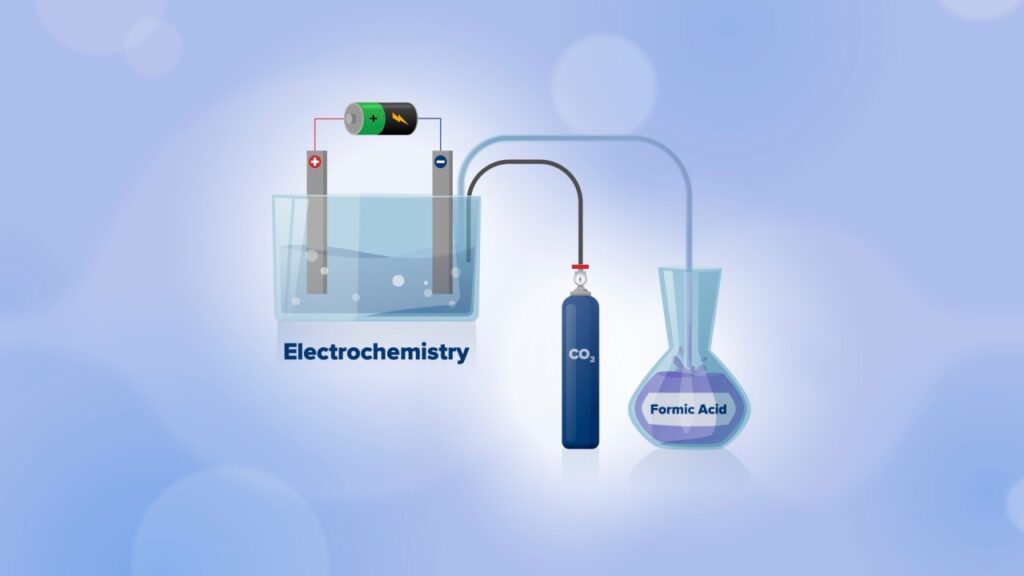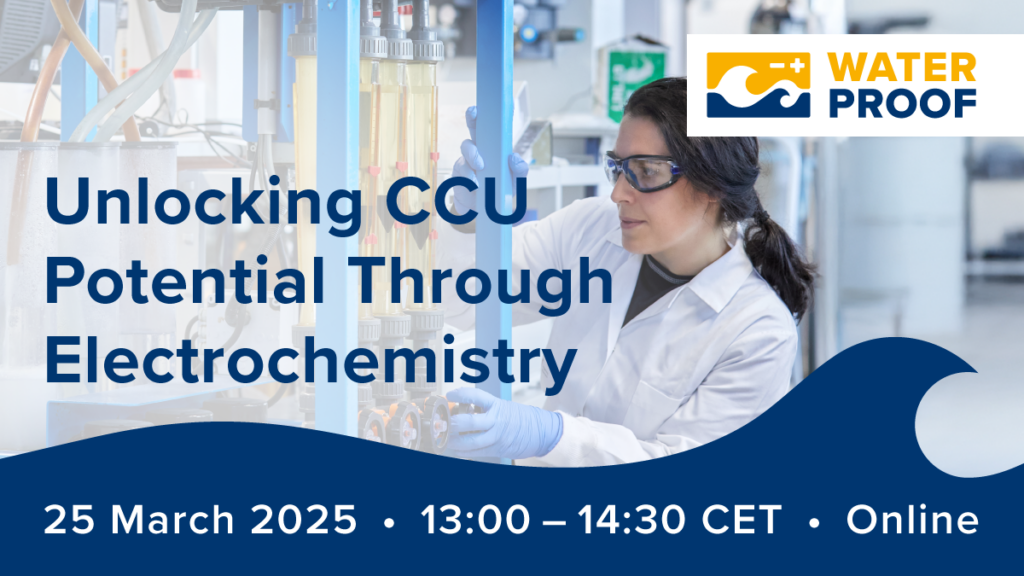Electrochemical CO₂ Conversion: Transforming Emissions into Valuable Chemicals
WaterProof-project upcoming webinar will demonstrate the potential and scalability of electrochemistry in CCU

The urgency of smart carbon management
The increasing concentration of carbon dioxide (CO₂) in the atmosphere is a major driver of global warming, prompting the urgent need for innovative solutions to mitigate climate change. Among the various strategies exploring CO2 utilisation, electrochemical CO₂ conversion stands out as a promising technology. This process uses electricity to transform CO₂ into valuable chemicals and fuels, offering a dual benefit: reducing greenhouse gas emissions and creating sustainable resources for the chemical and materials industries.
Fundamentals of electrochemical CO₂ conversion
Electrochemical CO₂ conversion involves CO₂ undergoing a reduction reaction within an electrochemical cell, driven by an electrical current. The key components are a CO₂ source from industrial point sources or direct air capture, and an electrocatalyst to facilitate the conversion reaction (Birdja et al., 2019). Ideally, the electrical current is supplied by renewable sources like solar or wind energy. An electrolyte solution is also necessary to conduct electricity and support the chemical reactions.
Electrochemical CO₂ reduction
Efficiency and selectivity of the electrochemical process are influenced by the electrocatalyst which determines the reaction pathway and product selectivity (Overa et al., 2022). Additionally, the applied electrode potential influences the reaction's driving force, impacting both the rate of electron transfer and the selectivity towards different products.
Versatile products of electrochemical CO₂ conversion
Electrochemical CO₂ conversion has the potential to produce a wide range of valuable chemicals. These include carbon monoxide (CO), and syngas (a mixture of CO and H₂), which serve as a feedstock for various chemical production processes and provide a versatile building block in chemical synthesis. But also formic acid (HCOOH), used in industries for leather tanning or as decalifier; methanol (CH₃OH), a promising renewable fuel or ethylene (C₂H₄), a key component in the production of plastics.
Advantages of electrochemical CO₂ conversion
Electrochemical CO₂ conversion offers several advantages over other carbon capture and utilisation (CCU) methods. Due to CCU processes being energy-intense, electrochemical conversion has the ability to integrate renewable energy sources directly without the need to use green hydrogen, making it a more sustainable option. The technology is scalable, stackable and suitable for both small-scale and large industrial plants. Another interesting approach is the electrochemical pH-swing (EPS). This process is an innovative carbon capture technique that uses electrochemical reactions to manipulate the pH of a solution, enabling the absorption of CO2 at high pH and its subsequent release at low pH, thus facilitating various carbon capture and utilisation (CCU) pathways (De et al., 2023). This approach offers versatility in CO2management, including the production of pure CO2 gas and bicarbonate solutions, which can be used for applications such as microalgae cultivation, while achieving CO2 capture efficiencies exceeding 90 % (De et al., 2023).
Challenges, recent and future research
Despite its promising benefits, electrochemical CO₂ conversion faces different challenges. Improving catalyst efficiency and selectivity is a key area of current research (Overa et al., 2022). Scaling up the technology for industrial implementation present challenges are related to reactor design and long-term stability. Another crucial point is reducing the energy consumption of the process (Nabil et al., 2021). The selection of appropriate electrolytes and solvents is essential to enhance CO₂ solubility and promote efficient electron transfer (Birdja et al., 2019).
Recent research is therefore focusing on overcoming these challenges. Advances in electrocatalytic systems include developing novel catalysts and reactor designs to enhance product selectivity and lower energy consumption (Overa et al., 2022). Molten Carbonate Fuel Cells (MCFCs) are also being explored for carbon capture applications (Bove et al., 2020). These high-temperature fuel cells use a molten carbonate salt mixture as an electrolyte, enabling efficient electricity generation (up to 60 %) and internal reforming of fuels like natural gas or biogas, while operating at temperatures above 600°C. The "electro-swing" (Faradaic electro-swing reactive adsorption – ESA) approach is gaining attention as a flexible method for integrating renewable energy sources (Wilcox, 2020). This innovative method captures CO2 from gas streams or ambient air using a specialized battery-like device.
WaterProof technology and upcoming webinar

One approach using electrochemical CO2 conversion is explored in the EU-funded research project WaterProof, in which CO2 from waste incineration and wastewater treatment facilities is transformed into formic acid. To introduce the potential of this innovative approach, WaterProof is hosting a webinar 25 March 2025, from 13:00-14:30 CET, where experts from research and industry will demonstrate the potential and scalability of electrochemistry in CCU.
Join these experts:
- Patrick Löb (Fraunhofer IMM): Flow reactors for the electrochemical CO2 reduction to formate/formic acid and beyond
- Brian Rawls (Avantium/Volta): Exploration of electrochemical production of CO₂-based polyesters and chemicals, and introduction of the WaterProof project’s technology for electrochemical CO₂ conversion into formic acid.
- Danny Hellebusch (Twelve): VP CO2 Electrolyzer
Registration: https://us02web.zoom.us/webinar/register/WN_ak2oiO83SYeyvGZCJPtJGw#/registration
Conclusion
Electrochemical CO₂ conversion presents a compelling strategy for carbon management. By leveraging renewable energy to transform CO₂ into valuable products, it can contribute to a more sustainable future. Continued research and development are essential to realise its full potential.
References
- Birdja, Y., Pérez-Gallent, E., Figueiredo, M., Göttle, A., Calle‐Vallejo, F., & Koper, M. (2019). Advances and challenges in understanding the electrocatalytic conversion of carbon dioxide to fuels. Nature Energy, 4, 732-745.
- Bove, D., Audasso, E., Barckholtz, T., Kiss, G., Rosen, J., & Bosio, B. (2020). Process analysis of molten carbonate fuel cells in carbon capture applications. International Journal of Hydrogen Energy.
- De, S., Won, D., Kim, J., & Kim, D. (2023). Integrated CO2 capture and electrochemical upgradation: the underpinning mechanism and techno-chemical analysis. Chemical Society Reviews.
- Nabil, S., McCoy, S., & Kibria, M. (2021). Comparative life cycle assessment of electrochemical upgrading of CO2 to fuels and feedstocks. Green Chemistry.
- Overa, S., Ko, B., Zhao, Y., & Jiao, F. (2022). Electrochemical Approaches for CO2 Conversion to Chemicals: A Journey toward Practical Applications. Accounts of Chemical Research.
- Wilcox, J. (2020). An electro-swing approach. Nature Energy, 5, 121-122.

WaterProof is funded by the European Union. Views and opinions expressed are however those of the author(s) only and do not necessarily reflect those of the European Union or European Health and Digital Executive Agency. Neither the European Union nor the granting authority can be held responsible for them.
Source: WaterProof, press release, 2025-03-24.
